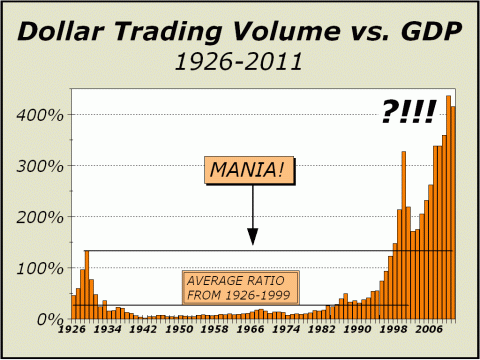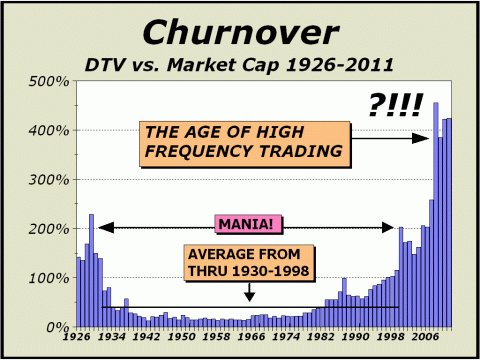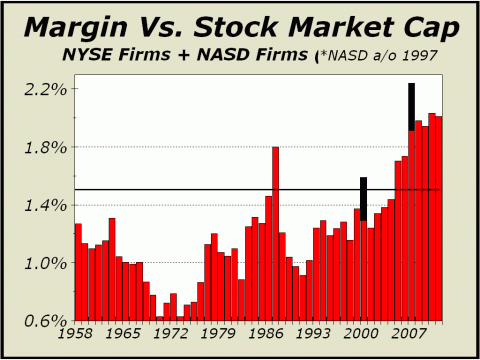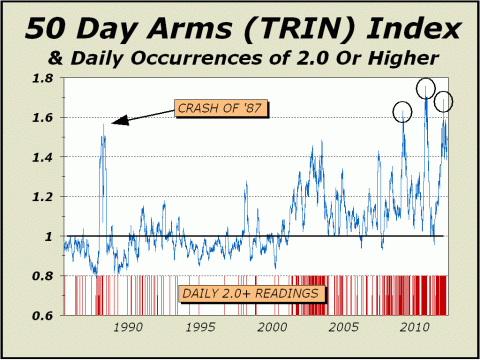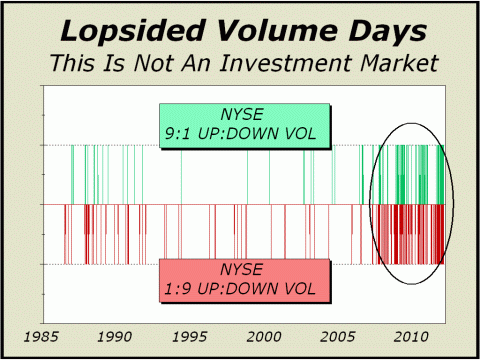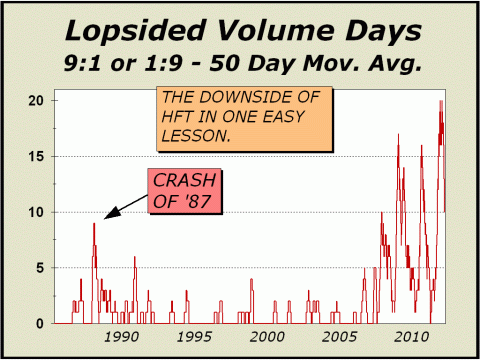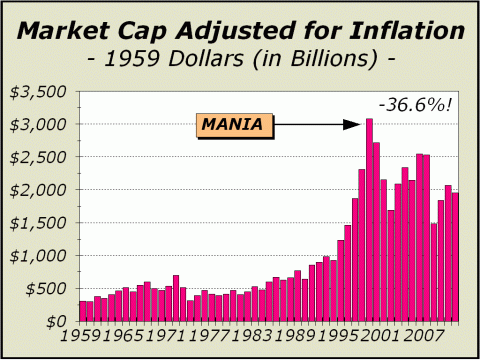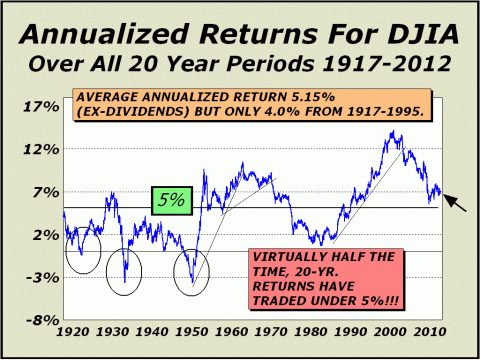
|
- THE GREATEST STOCK MARKET MANIA OF ALL TIME - DATED FEBRUARY 10, 2012 A SPECIAL REPORT BY ALAN M. NEWMAN, EDITOR CROSSCURRENTS This feature is now published on roughly a quarterly basis. Our next update will likely be published late in May or early June 2012 |
|
Our readership
is world-wide.
This report
is primarily a compilation of articles that have previously appeared in
the Crosscurrents newsletter.
Please check out the testimonials on our Kudos page. Printable
files of this report accompanied by our forecast are available only to
paid subscribers.
We spent a lot more time going over the stats for our usual lead focus on Dollar Trading Volume in this report. We're a little more confident that our numbers are pretty accurate, likely well within 1% of the actual total. That said, even a 1% difference when considering total DTV of over $63.5 trillion is nearly meaningless at this juncture. Over the last 15 years, DTV is growing at an annualized rate of 15.3%, an insane path that puts it on target to overwhelm any systems put into place and carefully designed to prevent calamity from another "Flash Crash" or worse yet, a series of flash crashes one after another. As is, DTV now represents 416% of our gross domestic product (GDP) and 423% of total stock market capitalization. These relative comparisons have accelerated since the very first signs of a mania appeared in 1996, an indisputable sign that the primary business of the nation is in the electronic trading of financial instruments, the most fundamental reason why economic growth is lacking, why unemployment is still high and why Americans display less confidence about the future. When the super bull market commenced in 1982, DTV was only 18.1% of GDP and 40.8% of total market cap. Thus, the relationship of trading to GDP is up 23-fold and to market cap is up more than ten-fold. Can these relationships remain headed in the same accelerated fashion for years to come? No! Consider that exchanges are now offering rebates for HFTs to provide liquidity, so they fill the system with bids and offers that may be canceled within microseconds, essentially serving no purpose at all, except to provide an illusion of liquidity. The "liquidity" is vacuous and really does not exist as the Flash crash ultimately proved in spades. Joe Saluzzi of Themis Trading (see www.themistrading.com) recently wrote, "Oversized rebates have distorted the price discovery process....HFT's can essentially make a profit by buying and selling a stock at the same price due to these rebates." Mr. Saluzzi's observation is easily the most pertinent and salient observation of 2011. No wonder trading has achieved the extremes of the last few years! Below, while our estimate places DTV roughly 2.2% below 2010, this year's estimate is likely far more accurate than last year's, which we admit could conceivably have been overstated. At some point, we will go over the data again to check the 2010 tally but we're not anxious to take on more work. In any event, if we are anywhere near accurate, DTV is up 22.2% over two years and that is a far more relevant statistic.
The churn continues at the most ferocious pace, making a mockery of our capital markets. The theme of investing for the future is now meaningless as HFT distorts price discovery, resulting in gross pricing inefficiencies. On a typical day in July 2011, trading averaged $243.4 billion, according to BATs (http://bit.ly/zHd3jM - month to date tab). Gross Domestic Product last year totaled $15.29 trillion. Divide by 365 days and you get $41.89 billion per day in GDP. Yes, we understand that the markets are closed two days each week but on days the markets are open, dollar trading volume is likely to run six times the total values of goods and services generated by the economy. Somehow, the stats for August 2011 reveal an astounding surge in DTV that we cannot even remotely account for. Volume picked up dramatically for six days early in the month and then reverted to what passes for normal nowadays but the surge was beyond comprehension. Average DTV soared by 42.4% in August and was up 64.3% for the BATs "exchange." Share volume rose 45.7% in
August.
All this is a month where volume traditionally contracts by 10%!!! None of this made the front
pages of the financial press,
This fact alone paints the nature of our capital markets as suspect. Simply put, no one really understands what is going on and the status quo is accepted, no matter what threats exist, because the business of transacting is now more important than a legitimate capital market. We believe the two pictures above and below speak for themselves quite well. The various U.S. stock markets are no longer a place where investments can be made because so much business is based on velocity. Indeed, as pointed out earlier, if "HFT's can essentially make a profit by buying and selling a stock at the same price due to these rebates," velocity is far more important than price. Logically, since price has
far less relevance than before,
There's no point in taking our chart below back beyond 1958, which will suffice for the modern era. That said, the modern era does not compare to what occurred during the Roaring Twenties, when stocks could be purchased for as little as ten cents on the dollar. The power of extraordinary leverage meant the possibility of enormous profits and gigantic losses and certainly, the Roaring Twenties provided both, but importantly, the former followed by the latter. The bar for 1987 was another example of concrete proof how leverage can build wealth and destroy it in short order. That bar was by far the highest leverage recorded since 1929 compared with total stock market capitalization (and incidentally, GDP). Lest we forget, stocks as measured by the Dow Industrials, were enabled to collapse by 23% in only one day as participants fled for the exits at whatever cost. As the tech mania took hold in 1999 and 2000, there was some talk perhaps the Federal Reserve would raise margin requirements to curb rampant speculation. Fed Chairman Alan Greenspan himself claimed raising margin requirements was unnecessary, since investors could take advantage of loans offered elsewhere to achieve the same result. Thus, it appeared the Fed was not only excusing leverage but encouraging same, taking no stance whatsoever on the possible risks involved. If speculators were going to pile on, so be it, and the Fed did not much care either way. In retrospect, this was likely Greenspan's greatest failing (amongst many). The lesson history teaches us is if we do not attempt to control leverage, it will most certainly go to excess and eventually destroy wealth. Thus, those who took the plunge near the top of the mania were soon in very hot water and excess leverage proved unable to sustain prices that were far, far above any realistic appraisal of the future. The same circumstance prevailed into the 2007 peak in prices as leverage became the only game in town. Margin as a percentage of both GDP and total market cap went to levels only seen once before, in 1929. It is instructive to understand that prices were cut in half from 200-2002 and 2007-2008 as leverage was unwound. Since the last surge in 2007, margin debt has remained excessively high versus both GDP and market cap, at one point reaching 2.3% of market cap in 2011, the second highest level since 1929. The three substantial peaks in margin for 1929, 2000 and 2007 all coincide with the most important market tops in the last century. Today, margin debt remains at levels consistent with another major reversal in prices. Excessive margin debt is proof that valuations are excessively high.
As more proponents of HFT enter
the arena to play the game,
All that counts is transactional
velocity.
HFT can only provide an illusion
of liquidity.
The following article was the
lead article in our November 7, 2011 issue.
Let's Compare Apples To The Planet Jupiter. We believe this is one of the
most important articles we have ever written,
We have been railing against high frequency trading for quite awhile and the evidence continues to pile up that HFT has quite effectively obviated the possibility of fair valuations for constituent issues. It has been widely noted that correlation's between individual stocks and indexes is now at an all time high. In other words, if the averages move up, more stocks move up than ever before. If the averages move down, more stocks move down than ever before. Why is this so deleterious to investors? Traditionally, security analysis has been utilized to discover value. In this fashion, shareholders of companies with bright futures are rewarded while shareholders of companies with suspect or dim futures are penalized. The result is an efficient market, with securities priced relative to their prospects. In today’s market, with correlation's this high, there is little reason to do the analysis to discover value, just buy or sell the entire index. Subsequently, we are experiencing what is likely the least efficiently priced stock market in our history. In this issue’s featured article, we will examine this problem from several perspectives, and hopefully make our case that while HFT reigns, those investors who have abandoned stocks will not return and those still participating will eventually abandon the arena to the algorithmic hyenas who feast on the remains of our once vaunted capital formation system. At center, a fifty-day moving average of the TRIN Index, coupled with all instances in which the daily reading was above 2.0. An explanation of the TRIN Index, invented by Richard Arms, can be found at http://bit.ly/sfl4AM. Suffice it to say that episodes of extremely high readings of 2.0 or higher are indicative of overwhelming or even panic selling pressure. It is extremely important that we view this chart in the light of the stock market Crash of ’87, a full fledged collapse that didn’t just happen in one day. From the August 25th print high for the Dow to the October 20th print low, there were 40 trading sessions. Thus, our 50-day average is entirely relevant. Despite the evidence that crashes are as rare as black swans, we have experienced three additional crash-type phases since 2007. While the economic background and fundamentals have clearly favored the downside, this crash behavior is apparent if only for the reason that HFT has greatly increased correlation. Of the two emotions that fuel price movement, fear is a far greater impetus for action than greed. Thus, it is now considerably easier for stocks to fall en masse and to decline precipitously. Does anyone truly want to invest in this environment?
Below, we view lopsided days in which volume runs 9 to 1 on the upside or 9 to 1 on the downside. Overwhelming buying or overwhelming selling. The first 22 years depict a history beginning only three years after the inception of a super bull market, a stock market crash and three bear markets, one of which cut stock prices in half. In fact, except for the crash, this was entirely normal behavior. In the 100 years leading to the new millennium, price declines of 20% or more occurred on average every 3.8 years, price declines of 25%+ occurred every 5.8 years and price declines of 30%+ occurred every 8.9 years. However, the few years since 2007 have been marked by an incredible surge in lopsided days, a behavior that has always been previously termed panic buying or panic selling. Thus, we are looking at and experiencing a radically different stock market than has ever existed before. It is no wonder that investors have been fleeing stocks for the relative safety and comfort of bonds and money markets. It may be a wonderful experience to be in stocks on a tremendous upside day in which they all move up emphatically, but it is truly horrific to experience the flip side of the coin. What investors value most is their ability to sleep comfortably at night. Volatility comforts no one.
And now (below), a 50-day moving average of lopsided days shows precisely how the current environment compares with the Crash of ’87—quite poorly. Note that our moving average quite often falls to zero, meaning no instances of lopsided volume and thus, comfort for investors. In fact, from the start of our chart to June 2007, shortly before one of the most significant stock market peaks in history, our 50-day moving average was at zero 58% of the time. Since then, there has been one stretch of only six days in which our average resided at zero, a paltry half of one percent. To say there is a dichotomy is completely insufficient. We’re not comparing apples to oranges, more like comparing apples to the planet Jupiter. Again, is it any wonder that investors do not want to be in stocks? In the last 26 weeks, only one has seen positive flows for domestic mutual funds. Never before have we seen a methodology overwhelm the U.S. stock market as HFT has. Not portfolio insurance, not even indexing has influenced stocks to the extent we are experiencing at present. And never before have we seen outflows from mutual funds as we see now.
Today’s regime is so patently rigged against investors that the SEC has limited their actions to mere hand slaps to favor all in an industry that rewards those who take every advantage. Yet another piece of evidence recently surfaced (see http://on.wsj.com/s7w6no) as the SEC fined Pipeline Trading Systems LLC. Pipeline was quoted as “pleased” with their settlement, in which they neither admitted nor denied wrongdoing. How many times have we heard that before? Hundreds? Meanwhile, one pro who researches dark pools was quoted in the article, “Judging from what's in the SEC allegations, this was a grave violation of customer confidence and trust.” A grave violation but no requirement of admission of wrongdoing. Just pay the fine and walk away. Is it any wonder that the public is deserting the arena? At center below, our table may more clearly illustrate how swings are still actually increasing even though they were already far in excess of any seen before in history. The statistics in the first row are for an entire decade, thus we experienced huge swings less than one-tenth as often as we do now. It is truly frightening to consider that we have already surpassed the previous record of 26 huge downside daily swings in 2008, when the financial system nearly collapsed. Yet, in less than a month, the S&P 500, a very broad measure, recently rallied by nearly 20% from print low to print high, in direct contradiction to our thesis that the public is gone. But the evidence is clear that we are correct. It’s not just the last 26 weeks of outflows; since the end of April 2007, only six months before prices peaked, more than $418 billion has flowed out of domestic funds. THIS TABLE WAS UPDATED FOR THIS
REPORT
Stocks are not rising for traditional
reasons, certainly not because they are undervalued.
Yes, upside momentum sometimes
seems strong, until it is not.
Expect more of the same in 2012.
The following article was published
in the December 19, 2011 issue.
The True Score. We are amazed that after so many years under water there are any stock bulls left at all, but this is a business that thrives on bullish sentiment. Wall Street and the financial media both have a vested interest in maintaining a bullish bias because that’s where the money is. The bullish bias even extends to professional advisors and newsletter writers. You can’t have a market when all the talk is doom and gloom, even if the logical view is doom and gloom, thus the outlook is typically promoted as bullish, whether short term, intermediate term or long term. In other words, supposedly, you can’t lose. In fact, the oldest saw in forecasting is never give both a price and time target together. One is sufficient and eventually you will be proved right with just a price target; all that is required is patience. This permanent bias is one reason why the mania was so fully embraced; all one needed to do was claim higher prices were ahead and somewhere down the road, the forecast would doubtless prove correct and the forecasts accorded greater confidence for the next upside forecast. We vividly remember some of the most outrageous forecasts when the mania was in full bloom, like those recounted at http://bit.ly/sYf20m. Whatever you do, read the quotes. [Ed. note: despite the popular wisdom, we wrote on February 28, 2000, that we expected Nasdaq to crash 35% within six weeks and within six weeks Nasdaq did indeed, crash by one-third] The bullish bias is still very much in view. While Europe teeters on the precipice and world financial markets remain under incredible pressure, we see very little in the way of fear, only complacency on a grand scale. While optimism is certainly nowhere near the levels of last winter and spring, events since then have cast one of the most memorable clouds on investing your Editor has seen in over four decades of observation. The current bull to bear ratio as measured by Investor’s Intelligence is roughly three bulls for every two bears. The ratio has improved sharply and is now well above its 10-week, 13-week and 26-week moving averages, indicating far less concern than earlier. Incredibly, while the Dow Industrials tanked from 12,606 on July 7th to 10,719 on August 10th, the number of adviser bulls expanded from 40.9% to 47.3%. Unfazed. An identical reading occurred on December 7th and last Wednesday’s number came in at 45.3% bulls. We can only interpret these relatively minimal concerns of advisers as complacency. Below, we admit our “true score” leaves out any allowance for dividends that have been returned to investors over time but in the last 12 years where we see market capitalization contracting by 36.6% adjusted for inflation, dividends have also contracted. From 1928 until 1995, dividends for the major indexes (the Dow and S&P 500) averaged almost 4.5% per year and were close to half of total returns. Since then, dividends have averaged only 1.9%. For Nasdaq and other stocks, the average dividend has been far lower or devoid of dividend entirely.
We estimate that even with
dividends included for the entire stock market,
HFT comprises approximately 73% of all trading. The evidence above is as solid as it gets. Trading and velocity cannot
build wealth.
Notable Quotes: "The stock market is now a
commodity market like any other.... .The world is more volatile because
stock-index futures exist"
"There has been a major shift
toward buying and selling aggregate portfolios all at once"
"There's a penalty for every
forward movement in technology... ..but the penalty can be intermittent,
volatile marketplaces"
"I think there is a tendency
today to substitute trading for investment"
"...our financial system is
gasping for capital because of....excess leverage and speculation....you
need capital to alight somewhere and build concrete things, rather than
buying things and selling things...,"
"It used to be you looked at
a company that had 10 million shares and you knew there were 10 million.
Now I wonder if there isn't an infinite number because of the use of these
derivative instruments"
"My gosh, what are we doing with our markets? If we don't learn from our mistakes, we are condemned to repeat them" - John W. Bachmann,former managing partner, Edward D. Jones & Co. ALTHOUGH ONE MIGHT GUESS THESE QUOTES ARE RECENT COMMENTS ABOUT OUR "INVESTMENT" MARKET, THEY ARE NOT. EACH OF THESE WERE UTTERED MORE THAN 24 YEARS AGO, SHORTLY AFTER THE STOCK MARKET CRASH OF OCTOBER 1987. "The real danger is that volatility
will shake out the long-term investor"
THIS PROPHECY HAS COME TRUE
How Does 2015 Sound?
How long can the secular bear possibly last? In Japan, stocks peaked in December 1989, fully 22 years ago, and the Nikkei closed 2011 an astonishing 78% lower than the all time high. This is the third secular bear market in the U.S. in the last 82 years. The first lasted 26 years, from 1929 to 1955. The second lasted 16 years from 1966-1982. While interim new highs were made in the Dow in the second and most recent secular bears, the broader indexes either remained well below their peaks or never convincingly broke out. Since 2003, we have repeatedly shown three compelling charts; the regression line for the Dow, 10-year rolling returns and 20-year rolling returns. We utilized the first chart to forecast the eventual bear market bottom of Dow 6400, check. We utilized the 10-year chart to forecast that 10-year returns would fall to zero, check. While we are not convinced that 20-year returns will fall to zero (see chart at bottom right), on a historical basis it is easy to see that rolling returns remain way higher than normal at 6.82%. The average dating back 95 years is 5.15% and that is with the benefit of a historic super bull market, wherein prices rose more than 15-fold from 1982 to 2000. From 1917 through 1995, a span of 79 years, returns were at the historic norm of 4%. We are convinced that 20-year annualized returns must at some point fall to near the historic norm and hasten to point out the three circled occasions in which returns actually fell to below zero. We’ll feel a bit better about the market’s longer term prospects when 20-year rolling returns fall to 5% and will feel a lot better should they fall to 4%. These levels can be accomplished with either a decline in price or by the passage of time or a combination of both. For instance, at Dow 12,500, it will be the end of June 2015 before the 5% level is achieved and early in May 2016 before the 4% level is touched. Heaven forfend if the Dow only moves sideways until 20-year rolling returns reach zero, because that would require extraordinary patience, out to January 2027.
Lower prices will enable stocks to achieve historic norms more quickly, but don’t get too excited. For instance, at Dow 10,000,
Of course, there are many other
iterations but the two we cite are as good as any,
To see a free sample copy of the Crosscurrents newsletter, CLICK HERE
We now have much greater confidence that the bear market bottom of Dow 6400 that we first forecast back in 2004 and that finally occurred in 2009, will wind up being the actual worst case scenario. While we must accord a modest chance a retest is possible, it appears a genuine retest need not even remotely approach the bottom seen in March 2009. Our projected worst case low for 2012 would likely be sufficient for us to turn bullish, provided the mutual fund cash-to-assets ratio expands to more than 6% and margin debt is cut in half from today's levels. Projected Best Case
Highs for 2012
Projected Worst
Case Lows for 2012
Reward/Risk Ratio: Remains Extremely Poor We expect volatility to begin to expand dramatically very soon. When volatility returns, prices will reverse sharply. THE CONTENTS OF THE ENTIRE WEBSITE ARE COPYRIGHT 2012 CROSSCURRENTS PUBLICATIONS, LLC I hope you have enjoyed your visit. Please return again and feel free to invite your friends to visit as well. Alan M. Newman, February 10, 2012 The entire Crosscurrents website has logged over three-and-a-half million visits. All information on this website is prepared from data obtained from sources believed reliable, but not guaranteed by us, and is not considered to be all inclusive. Any stocks, sectors or indexes mentioned on this page are not to be construed as buy, sell, hold or short recommendations. This report is for informational and entertainment purposes only. Persons affiliated with Crosscurrents Publications, LLC may be long or short the securities or related options or other derivative securities mentioned in this report. Our perspectives are subject to change without notice. We assume no responsibility or liability for the information contained in this report. No investment or trading advice whatsoever is implied by our commentary, coverage or charts. |
|
|
